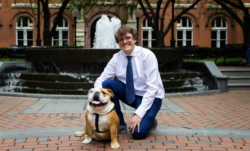Contracts disclosed under federal law reveal that the Georgetown University Alumni and Student Federal Credit Union and the Georgetown University Alumni Association signed a seven-year, $2.8 million affinity agreement with Bank of America in 2007.
The contract—which has existed at Georgetown in some form since 1984—pays royalties to GUASFCU and GUAA based on the number of credit card accounts opened by Georgetown students and alumni. GUASFCU and GUAA also provided customer lists of students and alumni to BoA for marketing purposes.
According to GUASFCU Chief Executive Officer Arjun Mehta (SFS ‘11), the University Registrar’s office compiled its customer list, which the Credit Union then passed on to BoA.
“At that time, we didn’t have the capacity to offer students credit cards,” Mehta said. “We saw the chance to give students the opportunity to build credit, help drive income towards the Alumni Association for scholarships, and help Bank of America. We considered it a win-win-win situation.”
Mehta added that the profits earned help GUASFCU raise interest rates and lower fees for customers.
Some experts have argued, however that such relationships can harm young customers.
“I think marketing credit cards to young people can lead to young people getting in trouble with credit card companies,” Ed Mierzinski, consumer program director of U.S. Public Interest Research Group, said.
Under the terms of the agreement, GUAA receives all royalties related to alumni credit card accounts, while GUAA and GUASFCU split student credit card royalties.
FIA Card Services, a subsidiary of Bank of America, pays $400,000 in annual advance payments to both organizations. GUAA and GUASFCU receive royalties for new credit card accounts, along with a portion of all retail purchases made on the accounts, and certain bonuses.
However, Mehta suggested royalty payments fell short of the six-figure maximum. Royalties have dropped in recent years to roughly $4,000 per year, he said.
While GUAA representatives did not comment before the deadline for this article, the organization’s website touts the agreement, noting that it “help[s] support student and alumni programming,” such as the John Carroll Scholarship, the Alumni Lounge in Village C.
“I blame the banks. I think it’s completely fine for colleges to have an affinity card that they market to students and alumni.” Mierzinski said. “But the agreements that I have seen have consistently allowed banks unparalleled and detailed access to demographic information about undergraduate students.”
Editor’s Note: Online headline edited to match that of the print edition on Friday, August 27 at 4pm.





How is a contract which has existed “in some form since 1984” exactly news?
What this article needs to mention is that this is a very old contract which as far as the Credit Union is concerned, is a referal program only. As the Credit Union only offered a debit card, when asked about a credit card we would refer them to this program which also helped the University. Its one thing to write a headline that captures attention, but another to purposefully blow the issue out of proportion 4 years later after it happened.
Since the credit union doesn’t have the balance sheet to offer credit cards on its own, they work with Bank of America to offer credit cards to students and alumni that choose to sign up for the service. And every time you use the card, Bank of America gives money to the Georgetown Alumni Association.
I fail to see the issue…
Is it just me or is this article completely pointless?